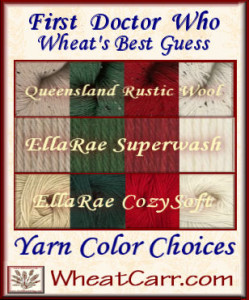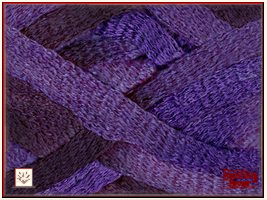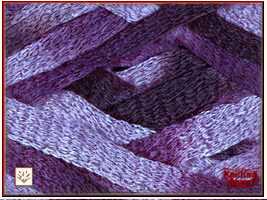» Currently browsing: Yarn
November 20th, 2013 at 11:11 am »
Comments (0)Introducing

Sooner or later everything reaches a tipping point. Or, as may not surprize – limitations and lunacy drive me to do start something. Past time to make some lemonade by finally launching a “dream project” AllJustString is intended to provide a place for personal development of our skills and knowledge, keep the information accessible and organized in a manner that will allow those who follow to find and benefit in a way not currently possible in other venues.
It is a founding principle that many of us don’t have craft-tunnel-vision – meaning that we enjoy many forms of craft and there is great diversity in how we each choose to bend our string. We can admire and respect those who practice a technique whether we choose to participate,
Our goal is help each other build on skills and knowledge and derivations – while giving our undying respect and support to those offering the opportunity to expand our knowledge and skill from the quick picture or video tutorials, to (at least in my home) a whole bookcase of others who have “done the research” and codified technique, and in many cases, the history of their chosen craft.
It is our obligation as an artisan (someone who works with their hands and their heart) to acknowledge as much as possible those who made our development possible. It is our ethical obligation to respect their copyrights and never feel we “need” to get attention by sharing that which is not ours to share.
At the end of the day, other than for marketing purposes, the only thing likely to be truly original is how you present it. And that work should be judged on your competence and vision.
Our goal is to help you find the knowledge and information you need, in a manner respectful to you, and to your sources of inspiration.
I hope you will join us – Ask and answer questions, suggest references, talk about your latest project – or show off what you have done – ask for peer review for a Work In Progress.
AllJustString, that gives us the freedom to enjoy one or many of its uses.
Blessing of the Seasons
Always Take Time To
Enjoy The Making
Wheat
July 16th, 2013 at 12:53 pm »
Comments (2)The first step in any project is always the planning and when you are working without a net (I mean pattern).
 There can be either devils or delights in the details. for this project I tried (but did not succeed) to limit to yarns in my stash and further limited my choices to those presently showing a good amount of stock at the KFI and Euro Warehouses.
There can be either devils or delights in the details. for this project I tried (but did not succeed) to limit to yarns in my stash and further limited my choices to those presently showing a good amount of stock at the KFI and Euro Warehouses.
Queensland Rustic Tweed: 63% Wool, 27% Alpaca, 7% Acrylic, 3% Viscose blend with approx 318 yards per 100gram
Ella Rae Superwash Classic 100% Wool with approx 220 yards per 100g ball.
Ella Rae Cozy Soft Solids 25% Superwash Wool, 75% Acrylic with approx 213 yards per 100g.
Like all fashion products, it can certainly be gone tomorrow, but at least it is here today. As you can see, this time I got lucky, yarn choices are always an issue of availability. Might not be easy next year, but at least today I know the ones I am using “have stock in the warehouse” so I should be able to yarn requirements estimated
 Last night I did this “digital” color stick – To lay out the color order and proportional width of each strip using the color swatch from The Ella Rae Superwash Classic. A color stick is used by designers to plan color sequences. When planning a sequence, it is basically the same as wrapping a ruler to determine the WPI (wraps per Inch) To get started, loosen about a yard of yarn from each skein adjusting the wraps to get the visual proportion you think best for your project. I like to start with the widest stripe.
Last night I did this “digital” color stick – To lay out the color order and proportional width of each strip using the color swatch from The Ella Rae Superwash Classic. A color stick is used by designers to plan color sequences. When planning a sequence, it is basically the same as wrapping a ruler to determine the WPI (wraps per Inch) To get started, loosen about a yard of yarn from each skein adjusting the wraps to get the visual proportion you think best for your project. I like to start with the widest stripe.

In the Blastr photo, it appears the taupe is about 2 inches wide or a tad more. The Cream/Natural and green – although different, look to have a consistent width and the red appears to have both a narrow and a medium
Tonight I will make stick using the sequence and proportions based on “eyeballing the photo”
The photo version looks to be a simple garter stitch, so I will need to decide on crochet stitches (standard and tunisian) that will give a similiar textural appearance. It may be take a few evenings to get a good combination. For most project I would then make larger swatches so one can be washed according to the label instructions to be sure the texture and drape will hold up under normal human conditions.
For scarfs, instead of the larger swatch, Ms Barbie (she is the 36 inch tall variety – you may have met her a few years at go at TNNA) will get a 1/2 size version – her twin Ms Bink will too and it will be washed washed according to the label instructions to see if any adjustments will need to be made to the Pattern Gauge.
This step might take more than a few evenings but as long as the AC holds up, who cares if the heat index is 110 outside.
P.S. Please feel free to share a link to this page – however, I prefer you do not copy and paste to another site. Among the reasons for this is that I update when I find newer/better information to include. Here is the direct link:
https://wheatcarr.com/dr-who/dr-who-the-new-guy-scarf.php
P.S. Jr. Caveat Exercens: The information contained in this blog post is based on the opinion and experience of Wheat Carr. These instructions may not be suitable for use by children of any age. Parental supervision and judgement should be exercised. My results are not a guarantee of future performance or your results especially when gauge is involved.
This blog post was created by/for WheatCarr.com July 2013 as a Whovain Fan and is not intended for commercial use. The Doctor Who brand is a trademark of the BBC. No infringement is intended or implied.
March 27th, 2013 at 10:20 am »
Comments (0)Common Types of Joins
This needs more work, but here are a few types of joins. And yes, I know it needs illustrations – maybe someday, but it is a place to start for today.
Admitting to a certain amount of AR, I do NOT KNOT. Knots are best left to Knotting, Netting and Macrame. Nor do I “seal” knots with fabric glue. If others find these useful and they are satisfied with the result, that is fine, just not for me.
With any method, you of course will also need to take into consideration repeats in the colorway of the yarn itself – this is particularly important when working with self patterning yarns to avoid disconcerting oddities in the finished project final appearance.
Assuming you have read your pattern thru completely before starting (hint) you may want to use consider which join will work best for your project while making your pattern swatch (hint, hint, often not the gauge swatch)
In reverse order of what I use most often:
The SPIT or often more politely referred to as a FELTED join – is dependent on its fiber content to determine if it is useful for your project in hand. Internet myth/assertion to the contrary. Neither Superwash (wool treated so it can be machine washed without major shrinkage) or Plant based fibers, (cotton, hemp, linen, etc) or man made (acrylic, microfibers, etc) will felt. They may LOOK felted but first time they get stressed (normal wearing or washing) they will come undone. –
I am most likely to use the spit method only when working with Sheeps wool and only for joining the same color.
Sometimes, if only because it is what I was taught by the “Cookie Lady” – a neighbor who taught me to crochet AND who made the world’s best cookies of many many varieties….
Next is layering or feathering. When you still have a yard left (just to make the handling easier) Separate the plys for 6-8 inches by untwisting them. Now “feather” each ply to a different length. It helps if you can pull out the fibers a bit at a time so each ply ends in a point. This I learned from the owner of my first LYS experience (her shop was next to the place we got our school uniforms) Mrs Goldman of Goldman yarns, you can read a bit about her at:
Repeat for the new yarn to be joined. Now match up each ply with the complimentary size, (longest with shortest) by over lapping and twisting each ply together. When all there are twisted, twist all together. This really take longer to type than to do for most 3 ply yarns.
This will work for most yarns, and even for threads.
Last but not least, the second method I learned (about age 6) is the RUSSIAN JOIN. It may be you will find it, as I do, the most useful of all. The RUSSIAN JOIN will generally work with any type of yarn, With a bit of care and an extra step or two, it is possible to place the join rather precisely and this is especially important when color changes are involved.
If you “google” Russian Join – there are dozens of illustrations –
You may have noticed with these three joins – NO KNOTS and NO ENDS TO WEAVE IN!
No ends that will eventually work their way out and lower the quality of your work.
Enjoy The Making
Wheat
MAIL: Wheat@ItsAllJustString.com
Read: Wheat Wrote WHAT! http://www.WheatCarr.com
Shop: ItsAllJustString.com http://www.ItsAllJustString.com
Like: FaceBook – http://www.facebook.com/ItsAllJustString
July 13th, 2012 at 15:53 pm »
Comments (0)
Acting on the theory that you should always have at least three WIPS * while thinking about upcoming holiday and other family and friend gifting, I am trying to decide which of these will be better for the well dressed Football fan, which do you think will work best for Baltimorians or Minnesotans?
(cousin comments especially welcomed)
Now if I can just find a colorway for NY Pinstripes…. for Stitch-n-Pitch in September
* WIPS – Works In Progress
July 8th, 2012 at 14:01 pm »
Comments (8)Caveat Emptor – Yeah I “used to” sell this stuff, but I also so use it….
Added: Sept 2015 – I recently was able to track down several copies of the Magazine with this pattern – not so difficult – with the “English Translation” – not so easy: if you are interested visit my e-store The exact yarn is not longer available to me.
Model 37 is such a dull name, Summer Citrus came to mind, so that’s my name and I plan to stick with it … If you are making this, I would love to hear about your experiences.

Every summer I try to do two projects, this one is from the current edition of the OnLine 2012 Spring Summer issue and uses Linie Alpha 11 my all time favorite dk mercerized cotton.
Took me almost two months to track down a supply of all the colors (two are no longer readily available in the US.) Now that my customers are taken care of there is even some left for me.
Took some time today to modify the magazine page shared on Facebook – the color names used in the US are different from the English Translation provided by OnLine so having this info where ever you shop will be something of a help.
Right now I am still in the “interviewing color combos” but I suspect that as specified is going to be it, except I may choose a softer yellow because that strong almost Sunflower Yellow is not really a good color for me. Perhaps I should make some color sticks and see what others think.
Between sizing it to fit, and the plan to lengthen the capped sleeve into at least a 3/4 sleeve (as we get older those upper arms are not nearly as nice as the model) I suspect it will not be available until NEXT summer Although I have a good start on the first yarn choices for the back center medallion.
The pattern is sized for Medium (36-28) and Large (40-42) I need to up-size emough that after medallion it will mean pretty like writing a whole new pattern because some measurements do change and some don’t.
Now that I have seen a view of the front – I am even more interested in working on it – the drop curve should be if not flattering at least not obnoxious looking.
I had forgotten how much I like this yarn, so guess it is time to build up an inventory
Time to go dig out the Pattern design paper and start drawing. Then TV Time will be back to working on the Medallion.
Enjoy The Making
Wheat
P.S. you can click on the image for a REALLY large look – so it may take time to load.


 There can be either devils or delights in the details. for this project I tried (but did not succeed) to limit to yarns in my stash and further limited my choices to those presently showing a good amount of stock at the
There can be either devils or delights in the details. for this project I tried (but did not succeed) to limit to yarns in my stash and further limited my choices to those presently showing a good amount of stock at the  Last night I did this “digital” color stick – To lay out the color order and proportional width of each strip using the color swatch from The Ella Rae Superwash Classic. A color stick is used by designers to plan color sequences. When planning a sequence, it is basically the same as wrapping a ruler to
Last night I did this “digital” color stick – To lay out the color order and proportional width of each strip using the color swatch from The Ella Rae Superwash Classic. A color stick is used by designers to plan color sequences. When planning a sequence, it is basically the same as wrapping a ruler to 


